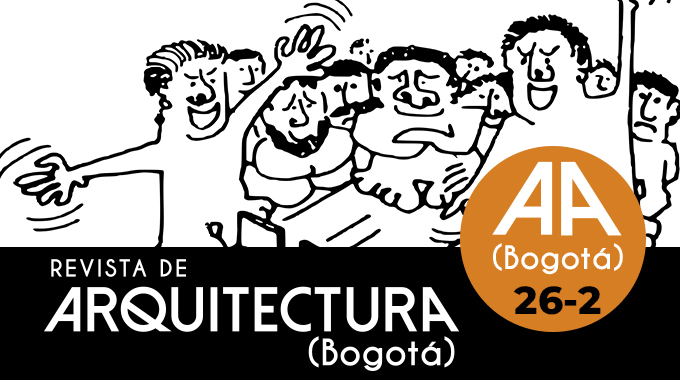

This work is licensed under a Creative Commons Attribution-NonCommercial 4.0 International License.
Revista de Arquitectura is an open access journal. More information...
Authors retain copyright and grant to the Revista de Arquitectura the right of first publication, which will be simultaneously subject to the Creative Commons (CC) BY-NC license.
Authors will sign a non-exclusive distribution license for the published version of the article by completing (RevArq FP03 Permission to Reproduce).
Self-archiving will comply with SHERPA/RoMEO guidelines and the Green classification.
To see in detail these guidelines, please consult...
Abstract
This article proposes to systematize three different approaches for addressing participatory instances in architecture, enabling interventions in the built environment through dialogue between professionals and neighbors. In order to clarify these approaches, the theoretical proposals of three architects who laid the foundations for participation in the design disciplines
during the 1960s and 1970s will be referenced: John Turner, Nicholas John Habraken and Christopher Alexander. While the contributions of these authors are generally recognized as foundational concepts in participatory architecture, this paper aims to interpret their writings through a methodological view in order to achieve not only a defense of user participation, but also different paths to implement it. In presenting the results, the various approaches are systematized according to their methodological elements (roles of professionals and residents, stages, and instruments). The discussion addresses the conceptual background of each proposal and the conclusions include a series of recommendations to guide methodological decisions in future participatory interventions based on contextual requirements and the professional practice perspectives.

References
Alexander, C. (1971). La estructura del medio ambiente. Tusquets.
Alexander, C. (1978). Urbanismo y participación: el caso de la Universidad de Oregón. Gustavo Gili.
Alexander, C. (1981). El modo intemporal de construir. Gustavo Gili.
Alexander, C., Silverstein, M., & Ishikawa, S. (1980). Un lenguaje de patrones: ciudades, edificios, construcciones. Gustavo Gili.
Baiges, C. (2014, 16 de julio). Metodologías. Arquitecturas Colectivas. Red Internacional de Colectivos. https://arquitecturascolectivas.net/herramientas/grupos/metodologias
Chávez, R., Viloria, J., Zipperer, M., & Turner, J. (2000, 11 de septiembre). Interview of John F. C. Turner. World Bank.
Di Siena, D. (2019). Libro blanco del método de diseño cívico versión 0.2. https://civicdesignmethod.com/portfolio/libro-blanco/
Fernández Castro, J. (2010). Barrio 31 Carlos Mugica. Posibilidades del proyecto urbano en contextos de pobreza. Instituto de la Espacialidad Humana.
Gyger, H. E. (2013). The informal as a project: Self-help housing in Peru. 1954-1986. Columbia University. https://doi.org/10.7916/D8DJ5NQF
Habraken, J. (1979). El diseño de soportes. Gustavo Gili.
Habraken, J. (1986). Towards a new professional role. Design Studies, 7(3), 139-143. https://doi.org/10.1016/0142-694X(86)90050-5
Habraken, J. (2002). The uses of levels. Open House International, 27(2), 2-17. https://habraken.com/html/downloads/the_uses_of_levels.pdf
Hidalgo Molina, D., & Arcos Aspiazu, A. M. (2018). Diseño participativo como instrumento para fomentar la enseñanza experimental de estudiantes de arquitectura: caso centro comunal al aire libre Barranca Central, Ecuador. AREA, (24), 327-345. https://area.fadu.uba.ar/wp-content/uploads/AREA24/AREA24_Hidalgo_Arcos.pdf
Mitchell, J., Berná Vaccarino, F., & Garro, J. (2020). Desarrollando herramientas de Diseño Participativo Sustentable en el Hábitat Social. Revista i+a, (23), 16-30. https://revistasfaud.mdp.edu.ar/ia/article/view/485/341
Murillo, F., & Schweitzer, M. (Dirs.). (2011). Planear el barrio: urbanismo participativo para construir el derecho a la ciudad. Cuentahilos. https://onuhabitat.org.mx/index.php/principios-de-planificacion-de-barrios
Palero, J. S. (2018). Arquitectura participativa: un estudio a partir de tres autores: Turner, Habraken y Alexander [Tesis doctoral]. Universidad Nacional de Córdoba. http://hdl.handle.net/11086/15135
Romero, G., Mesías, R., Enet, M., Oliveras, R., García, L., Coipel, M., & Osorio, D. (2004). La participación en el diseño urbano y arquitectónico en la producción social del hábitat. CYTED.
Turner, J. (1963). Dwelling resources in South America. Architectural Design, 8(33), 360-393. https://www.communityplanning.net/JohnFCTurnerArchive/pdfs/AD8-13Conclusion.pdf
Turner, J. (1976). La reeducación de un profesional. En J. Turner & R. Fichter, Libertad para construir. El proceso habitacional controlado por el usuario (pp. 131-153). Siglo veintiuno editores.
Turner, J. (1977). Vivienda, todo el poder para los usuarios. Blume.
































